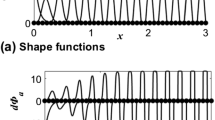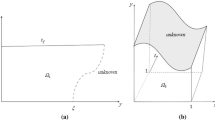Abstract
Our purpose is to establish a numerical method meeting the requirements of efficiency, stability, accuracy and easy-using. Faced with these demands, in this paper, a hybrid method combining the advantages of 2 weak-form meshless methods is proposed for solving steady and transient heat conduction problems with temperature-dependent thermophysical properties in heterogeneous media. In the process of the calculation for an arbitrary model discretized by the hybrid method, two different weak-form methods are used for the nodes categorized as: (1) boundary nodes, (2) near boundary interior nodes and (3) interior nodes. A Galerkin free element method (GFREM) is proposed for the interior nodes of the Cartesian grid; and the local radial point interpolation method (LRPIM) is used for the other two types of nodes. The GFREM using the Cartesian grid can greatly improve the accuracy and efficiency of the hybrid scheme. Special decomposition technology to determine the irregular integral domain for LRPIM can increase the flexibility for complex models. In addition, the full implicit finite difference scheme and Newton–Raphson method are used for solving transient nonlinear problems. And non-crossing interface integral domain and support domain are employed for heterogeneous media. Compared with other methods, numerical results show better accuracy, stability and efficiency from the numerical experiments.























Similar content being viewed by others
References
Alihemmati J, Beni YT (2019) Developing three-dimensional mesh-free Galerkin method for structural analysis of general polygonal geometries. Eng Comput. https://doi.org/10.1007/s00366-019-00749-6
Atluri SN, Kim HG, Cho JY (1999) A critical assessment of the truly meshless local Petrov–Galerkin (MLPG), and local boundary integral equation (LBIE) methods. Comput Mech 24(5):348–372. https://doi.org/10.1007/s004660050457
Atluri SN, Zhu TL (2000) The meshless local Petrov–Galerkin (MLPG) approach for solving problems in elasto-statics. Comput Mech 25(2–3):169–179. https://doi.org/10.1007/s004660050467
Bourantas GC, Mountris KA, Loukopoulos VC, Lavier L, Joldes GR, Wittek A, Miller K (2018) Strong-form approach to elasticity: hybrid finite difference-meshless collocation method (FDMCM). Appl Math Model 57:316–338. https://doi.org/10.1016/j.apm.2017.09.028
Buhmann MD (1993) New developments in the theory of radial basis function interpolation. pp 35–75. https://doi.org/10.1142/9789814503754-0003
Chen JS, Hillman M, Chi SW (2017) Meshfree methods: progress made after 20 years. J Eng Mech 143(4):04017001. https://doi.org/10.1061/(ASCE)EM.1943-7889.0001176
Chen JS, Wu CT, Yoon S, Yang Y (2015) A stabilized conforming nodal integration for Galerkin Meshfree methods. Int J Numer Methods Eng 0207:435–466. https://doi.org/10.1002/1097-0207(20010120)50
Cheng AD (2012) Multiquadric and its shape parameter-a numerical investigation of error estimate, condition number, and round-off error by arbitrary precision computation. Eng Anal Bound Elem 36(2):220–239. https://doi.org/10.1016/j.enganabound.2011.07.008
Chiang Y, Young D, Sladek J, Sladek V (2017) Local radial basis function collocation method for bending analyses of quasicrystal plates. Appl Math Model 50:463–483. https://doi.org/10.1016/j.apm.2017.05.051
Dehghan M (2006) Finite difference procedures for solving a problem arising in modeling and design of certain optoelectronic devices. Math Comput Simul 71(1):16–30. https://doi.org/10.1016/j.matcom.2005.10.001
Fang J, Zhao GF, Zhao J, Parriaux A (2009) On the truly meshless solution of heat conduction problems in heterogeneous media. Numer Heat Transf Part B Fundam 55(1):1–13. https://doi.org/10.1080/10407790802605067
Fantuzzi N (2015) New insights into the strong formulation finite element method for solving elastostatic and elastodynamic problems. Curved Layer Struct 1:94–127. https://doi.org/10.2478/cls-2014-0005
Fantuzzi N, Tornabene F, Bacciocchi M, Neves AM, Ferreira AJ (2017) Stability and accuracy of three Fourier expansion-based strong form finite elements for the free vibration analysis of laminated composite plates. Int J Numer Methods Eng 111(4):354–382. https://doi.org/10.1002/nme.5468
Fantuzzi N, Tornabene F, Viola E, Ferreira A (2014) A strong formulation finite element method (SFEM) based on RBF and GDQ techniques for the static and dynamic analyses of laminated plates of arbitrary shape. Meccanica 49(10):2503–2542. https://doi.org/10.1007/s11012-014-0014-y
Feng WZ, Gao XW (2016) An interface integral equation method for solving transient heat conduction in multi-medium materials with variable thermal properties. Int J Heat Mass Transf 98:227–239. https://doi.org/10.1016/j.ijheatmasstransfer.2016.02.086
Flyer N, Fornberg B, Bayona V, Barnett GA (2016) On the role of polynomials in RBF-FD approximations: I. Interpolation and accuracy. J Comput Phys 321:21–38. https://doi.org/10.1016/j.jcp.2016.05.026
Franke R (1982) Scattered data interpolation: test of some methods. Math Comput 38:181–200. https://doi.org/10.2307/2007474
Gao XW, Gao LF, Zhang Y, Cui M, Lv J (2019) Free element collocation method: a new method combining advantages of finite element and mesh free methods. Comput Struct 215:10–26. https://doi.org/10.1016/j.compstruc.2019.02.002
Gao XW, Huang SZ, Cui M, Ruan B, Zhu QH, Yang K, Lv J, Peng HF (2017) Element differential method for solving general heat conduction problems. Int J Heat Mass Transf 115:882–894. https://doi.org/10.1016/j.ijheatmasstransfer.2017.08.039
Gao XW, Li ZY, Yang K, Lv J, Peng HF, Cui M, Ruan B, Zhu QH (2018) Element differential method and its application in thermal-mechanical problems. Int J Numer Methods Eng 113(1):82–108. https://doi.org/10.1002/nme.5604
Gao XW, Liang Y, Xu BB, Yang K, Peng HF (2019) Cross-line elements for free element method in thermal and mechanical analyses of functionally gradient materials. Eng Anal Bound Elem 108:422–437. https://doi.org/10.1016/j.enganabound.2019.08.024
Hardy R (1971) Multiquadric equations of topography and other irregular surfaces. J Geophys Res 76:1905–1915. https://doi.org/10.1029/JB076i008p01905
Hidayat MIP (2019) Meshless local B-spline collocation method for heterogeneous heat conduction problems. Eng Anal Bound Elem 101:76–88. https://doi.org/10.1016/j.enganabound.2018.12.015
Hosseini SM, Sladek J, Sladek V (2019) Anisotropic transient thermoelasticity analysis in a two-dimensional decagonal quasicrystal using meshless local Petrov–Galerkin (MLPG) method. Appl Math Model 66:275–295. https://doi.org/10.1016/j.apm.2018.09.024
Hu W, Gu Y, Zhang C, He X (2019) The generalized finite difference method for an inverse boundary value problem in three-dimensional thermo-elasticity. Adv Eng Softw 131:1–11. https://doi.org/10.1016/j.advengsoft.2019.02.006
Jianjun Y, Jianlong Z (2017) Meshless local strong–weak (MLSW) method for irregular domain problems. Chin J Theor Appl Mech 58(4):478–485. https://doi.org/10.1007/s11434-012-5471-x
Li M, Wen PH (2014) Finite block method for transient heat conduction analysis in functionally graded media. Int J Numer Methods Eng 99(5):372–390. https://doi.org/10.1002/nme.4693
Ling J, Yang DS, Zhai BW, Zhao ZH, Gong H (2017) Solving the single-domain transient heat conduction with heat source problem by virtual boundary meshfree Galerkin method. Int J Heat Mass Transf 115:361–367. https://doi.org/10.1016/j.ijheatmasstransfer.2017.08.061
Liu G (2016) An overview on meshfree methods: for computational solid mechanics. Int J Comput Methods 13(05):1630001. https://doi.org/10.1142/s0219876216300014
Liu G, Gu Y (2001) A local radial point interpolation method (LRPIM) for free vibration analyses of 2-d solids. J Sound Vib 246(1):29–46. https://doi.org/10.1006/jsvi.2000.3626
Liu G, Kee BB, Chun L (2006) A stabilized least-squares radial point collocation method (LS-RPCM) for adaptive analysis. Comput Methods Appl Mech Eng 195(37–40):4843–4861. https://doi.org/10.1007/s00466-006-0145-7
Liu HY, Gao XW, Xu BB (2019) An implicit free element method for simulation of compressible flow. Comput Fluids 192:104276. https://doi.org/10.1016/j.compfluid.2019.104276
Liu X, Liu GR, Tai K, Lam KY (2005) Radial point interpolation collocation method (RPICM) for partial differential equations. Comput Math Appl 50(8):1425–1442. https://doi.org/10.1016/j.camwa.2005.02.019
Madych W, Nelson S (1992) Bounds on multivariate polynomials and exponential error estimates for multiquadric interpolation. J Approx Theory 70:94–114. https://doi.org/10.1016/0021-9045(92)90058-V
Nayroles B, Touzot G, Villon P (1992) Generalizing the finite element method: diffuse approximation and diffuse elements. Comput Mech 10(5):307–318. https://doi.org/10.1007/BF00364252
Perazzo F, Lohner R, Perez-Pozo L (2008) Adaptive methodology for meshless finite point method. Adv Eng Softw 39(3):156–166. https://doi.org/10.1016/j.advengsoft.2007.02.007
Repka M, Sladek V, Sladek J (2019) Numerical study of size effects in micro/nano plates by moving finite elements. Compos Struct. https://doi.org/10.1016/j.compstruct.2019.01.010
Sadat H, Dubus N, Gbahoue L, Sophy T (2006) On the solution of heterogeneous heat conduction problems by a diffuse approximation meshless method. Numer Heat Transf Part B Fundam 50(6):491–498. https://doi.org/10.1080/10407790600710184
Saeedpanah I, Jabbari E (2010) Local Heaviside-weighted LRPIM meshless method and its application to two-dimensional potential flows. Int J Numer Methods Fluids 59(5):475–493. https://doi.org/10.1002/fld.1810
Safarpoor M, Shirzadi A (2019) Numerical investigation based on radial basis function-finite-difference (RBF-FD) method for solving the Stoke–Darcy equations. Eng Comput. https://doi.org/10.1007/s00366-019-00863-5
Safarpoor M, Takhtabnoos F, Shirzadi A (2019) A localized RBF-MLPG method and its application to elliptic PDEs. Eng Comput. https://doi.org/10.1007/s00366-018-00692-y
Shankar V (2016) The overlapped radial basis function-finite difference (RBF-FD) method: a generalization of RBF-FD. J Comput Phys. https://doi.org/10.1016/j.jcp.2017.04.037
Wang L (2017) Radial basis functions methods for boundary value problems: performance comparison. Eng Anal Bound Elem 84:191–205. https://doi.org/10.1016/j.enganabound.2017.08.019
Wen P, Hon Y, Li M, Korakianitis T (2013) Finite integration method for partial differential equations. Appl Math Model 37(24):10092–10106. https://doi.org/10.1016/j.apm.2013.05.054
Wen PH, Aliabadi MH (2012) A hybrid finite difference and moving least square method for elasticity problems. Eng Anal Bound Elem 36(4):600–605. https://doi.org/10.1016/j.enganabound.2011.10.002
Wen PH, Cao P, Korakianitis T (2014) Finite block method in elasticity. Eng Anal Bound Elem 46:116–125. https://doi.org/10.1016/j.enganabound.2014.05.006
Wendland H (1998) Error estimates for interpolation by compactly supported radial basis functions of minimal degree. J Approx Theory 93(2):258–272. https://doi.org/10.1006/jath.1997.3137
Yang J, Zheng J (2013) Intervention-point principle of meshless method. Chin Sci Bull 58(4):478–485. https://doi.org/10.1007/s11434-012-5471-x
Zhang J, Zhou G, Gong S, Wang S (2017) Transient heat transfer analysis of anisotropic material by using element-free Galerkin method. Int Commun Heat Mass Transf 84:134–143. https://doi.org/10.1016/j.icheatmasstransfer.2017.04.003
Zvan R, Forsyth PA, Vetzal KR (1997) Penalty methods for American options with stochastic volatility. J Comput Appl Math 91(2):199–218. https://doi.org/10.1016/s0377-0427(98)00037-5
Author information
Authors and Affiliations
Corresponding author
Additional information
Publisher's Note
Springer Nature remains neutral with regard to jurisdictional claims in published maps and institutional affiliations.
Rights and permissions
About this article
Cite this article
Xu, BB., Gao, XW. & Cui, M. An efficient and accurate hybrid weak-form meshless method for transient nonlinear heterogeneous heat conduction problems. Engineering with Computers 38, 969–984 (2022). https://doi.org/10.1007/s00366-020-01050-7
Received:
Accepted:
Published:
Issue Date:
DOI: https://doi.org/10.1007/s00366-020-01050-7




